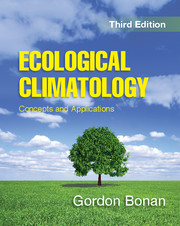Book contents
- Frontmatter
- Dedication
- Contents
- Preface
- 1 Ecosystems and Climate
- Part I The Earth System
- Part II Global Physical Climatology
- Part III Hydrometeorology
- Part IV Biometeorology
- Part V Terrestrial Plant Ecology
- 18 Plant Strategies
- 19 Populations and Communities
- 20 Ecosystems
- 21 Soil Biogeochemistry
- 22 Vegetation Dynamics
- 23 Landscapes and Disturbances
- 24 Global Biogeography
- Part VI Terrestrial Forcings and Feedbacks
- Appendix
- Index
- Plate section
- References
24 - Global Biogeography
from Part V - Terrestrial Plant Ecology
Published online by Cambridge University Press: 05 November 2015
- Frontmatter
- Dedication
- Contents
- Preface
- 1 Ecosystems and Climate
- Part I The Earth System
- Part II Global Physical Climatology
- Part III Hydrometeorology
- Part IV Biometeorology
- Part V Terrestrial Plant Ecology
- 18 Plant Strategies
- 19 Populations and Communities
- 20 Ecosystems
- 21 Soil Biogeochemistry
- 22 Vegetation Dynamics
- 23 Landscapes and Disturbances
- 24 Global Biogeography
- Part VI Terrestrial Forcings and Feedbacks
- Appendix
- Index
- Plate section
- References
Summary
Chapter Summary
The structure and composition of vegetation and the functioning of terrestrial ecosystems, which at a local scale are shaped by environmental factors such as temperature and moisture, are also influenced by global climate. This is seen in the biogeography of vegetation and in the global carbon cycle. The geographic distribution of biomes closely correlates with temperature, precipitation, and evapotranspiration, and so, too, do annual net primary production and decomposition rates. Long-term changes in climate alter the biogeography and functioning of Earth's ecosystems. Global models of the terrestrial biosphere provide a quantitative framework to understand planetary ecology and the role of terrestrial ecosystems in the climate system.
Plant Geography
The broad influence of climate on macroscale ecology is evident when the complexity and diversity of terrestrial communities and ecosystems are reduced to a few biomes, or broad classes of vegetation (e.g., forest, grassland, shrubland, or desert). The natural vegetation of Earth has a distinct geographic pattern that corresponds to climate zones (Figure 2.4). The close correspondence between climate zones and biomes is readily apparent because climate zones such as tropical savanna, tropical rainforest, and tundra are named after vegetation (Table 6.1).
Tropical evergreen forests (tropical rainforests) are the dominant vegetation in hot, wet equatorial regions of South America, Africa, Southeast Asia, and Indonesia. In these regions, monthly temperatures are warm year-round, precipitation is abundant, and there is little seasonal variation in temperature or rainfall. Annual production is high. Trees are tall, often higher than 30 m, and form a thick canopy of broadleaf evergreen leaves through which little sunlight penetrates. The warm, wet conditions are optimal for decomposition so that little litter accumulates on the forest floor. Climate corresponds to the tropical rainforest zone (Figure 6.1). In tropical regions that are warm year-round but have a dry season, tropical deciduous forests are common. These drought-deciduous trees lose their leaves during the dry season. They are smaller than their rainforest counterparts and have less dense canopy coverage.
- Type
- Chapter
- Information
- Ecological ClimatologyConcepts and Applications, pp. 422 - 450Publisher: Cambridge University PressPrint publication year: 2015



